The chromatic scale is a fundamental pillar of Western music, encompassing a rich palette of 12 unique tones.
It can help unlock the doors to intricate harmonies, elevate sampling techniques, and offer endless creative explorations.
As a music producer, knowing the chromatic scale, and other scales, can drastically enhance your compositional abilities.
This way, you can create legendary (and addicting) tracks that resonate with all 12 notes.
Luckily, we’ll be breaking down everything you need to know about the chromatic scale, so you can leverage its full potential and enhance your production workflow.
In today’s blog post, we’ll be breaking down:
- Chromatic scale basics ✓
- Its significance for digital music producers ✓
- Ascending vs. descending scales (and other common scales)✓
- Chromatic vs. diatonic differences ✓
- Role in Western music ✓
- Sampling techniques ✓
- Creating epic beats with the chromatic scale ✓
- Integrating with other scales ✓
- Common misunderstandings ✓
- Professional tips, tricks, and techniques ✓
By the end of this article, you’ll have a solid understanding of the chromatic scale and its nuances, applications, and significance.
With this knowledge, you’ll be equipped to craft intricate musical compositions.
As well as create captivating sonic landscapes and produce music like a seasoned professional; captivating anyone who hears it.
So, let’s dive in…
Table of Contents
- What is the Chromatic Scale?
- Why Should Music Producers Care About It?
- The Basics: All Twelve Tones and the Musical Alphabet
- Ascending Chromatic Scale vs. Descending Chromatic Scale
- Differences Between Chromatic Scales and Diatonic Scales
- The Role of the Chromatic Scale in Western Music
- Relationship with Major and Minor Scales
- Enharmonic Equivalents and Key Signatures
- Chromatic Scale: Final Thoughts
What is the Chromatic Scale?

The chromatic scale encompasses all twelve notes of the ‘musical alphabet’ in sequential order.
These notes/pitches are separated by the smallest musical interval pattern used in classical Western music: the half-step or semitone.
Pretend you’re playing your piano keyboard…
If you start on a note, say middle C, and play every white key and black key consecutively until you reach the next C, you’ve just played a C chromatic scale.
It’s a full spectrum of notes available within an octave.
Unlike many other scales (like the Major or Minor scale), the chromatic scale doesn’t confine itself to a particular key signature.
It’s a free-flowing entity, presenting every musical pitch without restriction.
It provides a canvas where every shade of note is available 一 enabling vast musical expression and unparalleled flexibility.
NOTE: The chromatic scale is more than just a sequence of notes or interval pattern.
It’s a tool of white keys and black notes, black keys and white notes, a foundation.
And, in many ways, a unique scale playground for artists, composers, and music producers to explore their creativity.
Why Should Music Producers Care About It?

At a glance, the chromatic scale may appear as just another component of Music Theory, but for digital music producers, it can unleash endless creativity.
Understanding the chromatic scale can unlock innovative avenues in composition, sampling, and music production.
In today’s digital era, music often transcends traditional boundaries.
Genres meld, sounds are sampled from various sources, and there’s a constant pursuit for a unique sonic fingerprint.
The chromatic scale (with its 12 tones) provides the foundation to venture into diverse musical territories 一 helping your music stand out and shine.
Furthermore, many modern music genres, including jazz, R&B, electronic, and hip-hop, leverage chromaticism.
Being fluent in the chromatic scale allows producers to:
- Infuse intricate harmonies
- Craft unexpected melodies
- Manipulate samples with a fresh twist
Lastly, many digital instruments and software plugins utilize a chromatic layout.
Familiarity with this scale ensures you can seamlessly integrate these tools into your workflow and expand your sound palette.
Needless to say, if you’re looking to create unique and intriguing beats, the chromatic can help get you there.
The Basics: All Twelve Tones and the Musical Alphabet

The chromatic scale is essentially the ‘whole package’ of the musical world.
It encapsulates every note available in Western music, spanning from one note to its same note one octave higher.
This includes every black key and white key on a piano keyboard.
While the diatonic scale (like the Major scale or Minor scale) chooses specific notes, creating the familiar “do-re-mi” progression, the chromatic scale leaves no note behind.
Beginning on any note, the scale progresses by semitone intervals (half steps).
For instance, let’s look at the chromatic scale starting with C:
- C
- C#
- D
- D#
- E
- F
- F#
- G
- G#
- A
- A#
- B
- Back to C again
Each of these notes or ‘tones’ has a unique sonic identity.
For producers, each tone represents an individual color in their sonic palette 一 allowing for immense flexibility and variation in music creation.
Understanding this sequence (especially on instruments like a piano keyboard or MIDI keyboards) is not only encouraged, but crucial.
It aids in faster note identification, efficient software utilization, and improvisational skills; making it truly invaluable.
Ascending Chromatic Scale vs. Descending Chromatic Scale
While the concept is straightforward, directionality plays a role in the chromatic scale’s notation and execution.
Ascending chromatic scales and descending chromatic scales aren’t merely opposites.
They bring about different tonal perceptions, feels, and notations.
-
An Ascending Chromatic Scale Traditionally Uses Sharps (#)

So, if you start on a C and ascend chromatically, you’d progress through notes like C, C#, D, D#, and so forth.
The use of sharps gives an upward motion feeling 一 as if each individual note is reaching out for the next.
-
The Descending Chromatic Scale Leans Towards the Use of Flats (b)

From a C, descending order would look like C (the first note), B, Bb, A, Ab (the last note), and so on, presenting a sense of downward motion, a return or resolution.
This distinction aids in creating tension and release in compositions.
Whether it’s building up to a climax with an ascending chromatic run or resolving a melody with a descending line, understanding these nuances can make a piece stand out.
Differences Between Chromatic Scales and Diatonic Scales
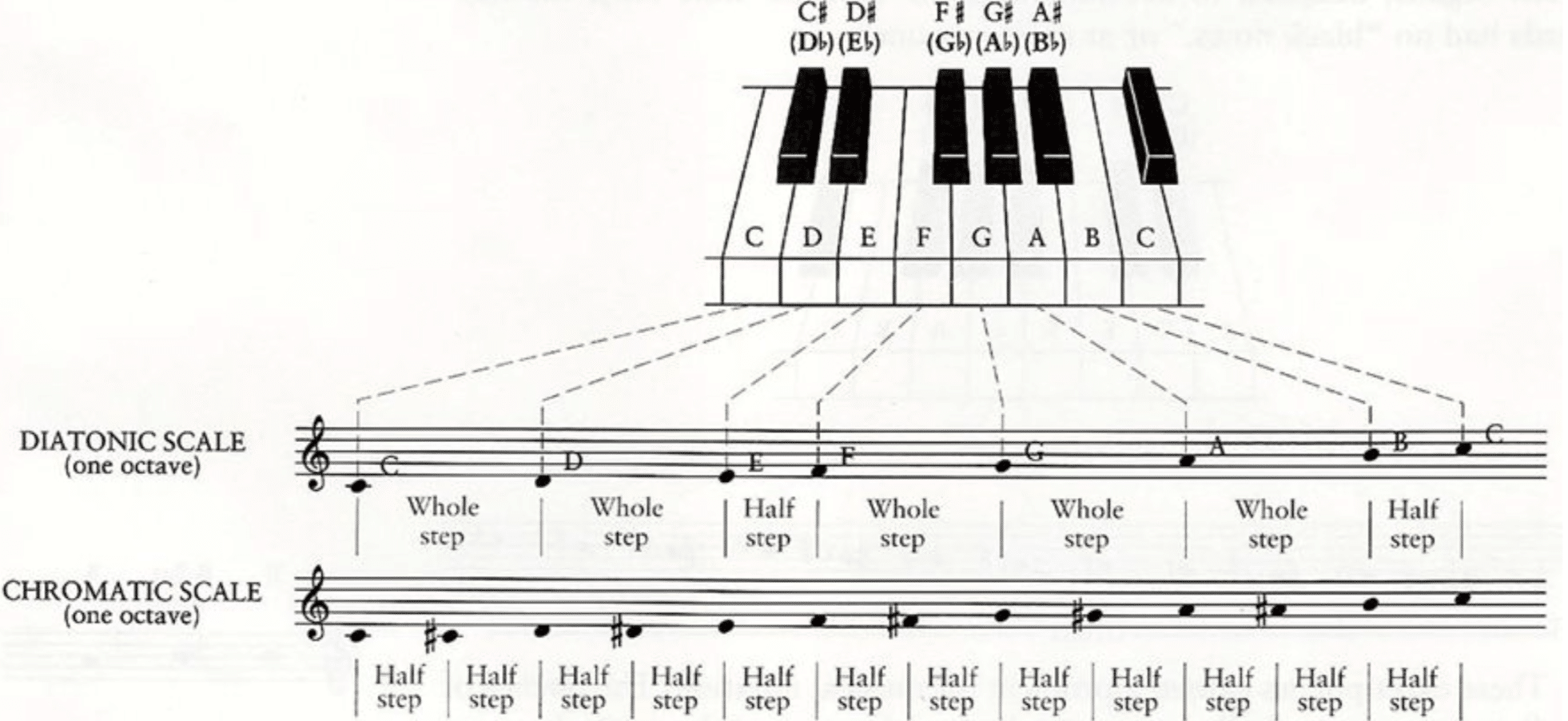
On the surface, both chromatic and diatonic scales are simple and straightforward sequences of musical notes.
However, their construction, purpose, and sonic outcomes vary significantly.
As previously mentioned, the chromatic scale includes all twelve tones without discrimination.
On the other hand, diatonic scales are more selective, consisting of seven pitches (extracted from the 12 available tones).
Major scales and Minor scales are prime examples of diatonic scales, as their selective nature provides them with a specific character and mood.
Think of the cheerful disposition of a Major scale versus the somber tone of a Minor scale; this is a perfect example.
For music producers:
- The chromatic scale 一 Is like a vast canvas, offering endless possibilities.
- Diatoinc scales 一 Provide a guided framework, conducive for specific tonal narratives.
In other words, the chromatic scale allows for nuanced shades and transitions, while the diatonic scale is ideal for conveying a specific mood, vibe, or emotional response.
Mastering both is the key to versatile and dynamic music production.
It can make all the difference in relaying the desired emotion or atmosphere in your tracks and help your music have that deeply resonating result.
The Role of the Chromatic Scale in Western Music

The chromatic scale is foundational in Western Music Theory.
While it may not frequently serve as the primary scale for entire compositions, its notes pop up everywhere to add:
- Color
- Tension
- Variation
The rich harmonies in classical compositions, the signature riffs in jazz, and the surprising twists in popular songs; many derive from the chromatic palette.
Classical composers like Bach and Chopin often employed chromaticism in their works.
For example, Bach’s “Chromatic Fantasy and Fugue” is an exploration of chromatic sequences, producing a haunting and intense sound.
In modern times, the chromatic scale is frequently used for modulations in songs, to successfully move from one key to another.
It provides a smooth bridge 一 allowing for diverse musical expressions within a single composition.
Also, the chromatic scale is fundamental to the concept of tension and release in Western music.
Notes separated outside of the primary diatonic scale can introduce tension, and their resolution into diatonic notes produces release, giving music its emotive power.
NOTE
The C chromatic scale serves as a fundamental example when notating chromatic scales in Western music.
The word “chromatic” essentially means color, and this scale truly brings color to music by encompassing all the notes available in the Western musical palette.
Relationship with Major and Minor Scales
While the chromatic scale spans all twelve tones without bias, Major and Minor scales are more selective.
They each pick seven out of those twelve, but they choose differently 一 leading to distinct emotional tonalities.
Don’t worry, we’ll break down the basics, no need for a Music Theory exam.
-
A Major Scale
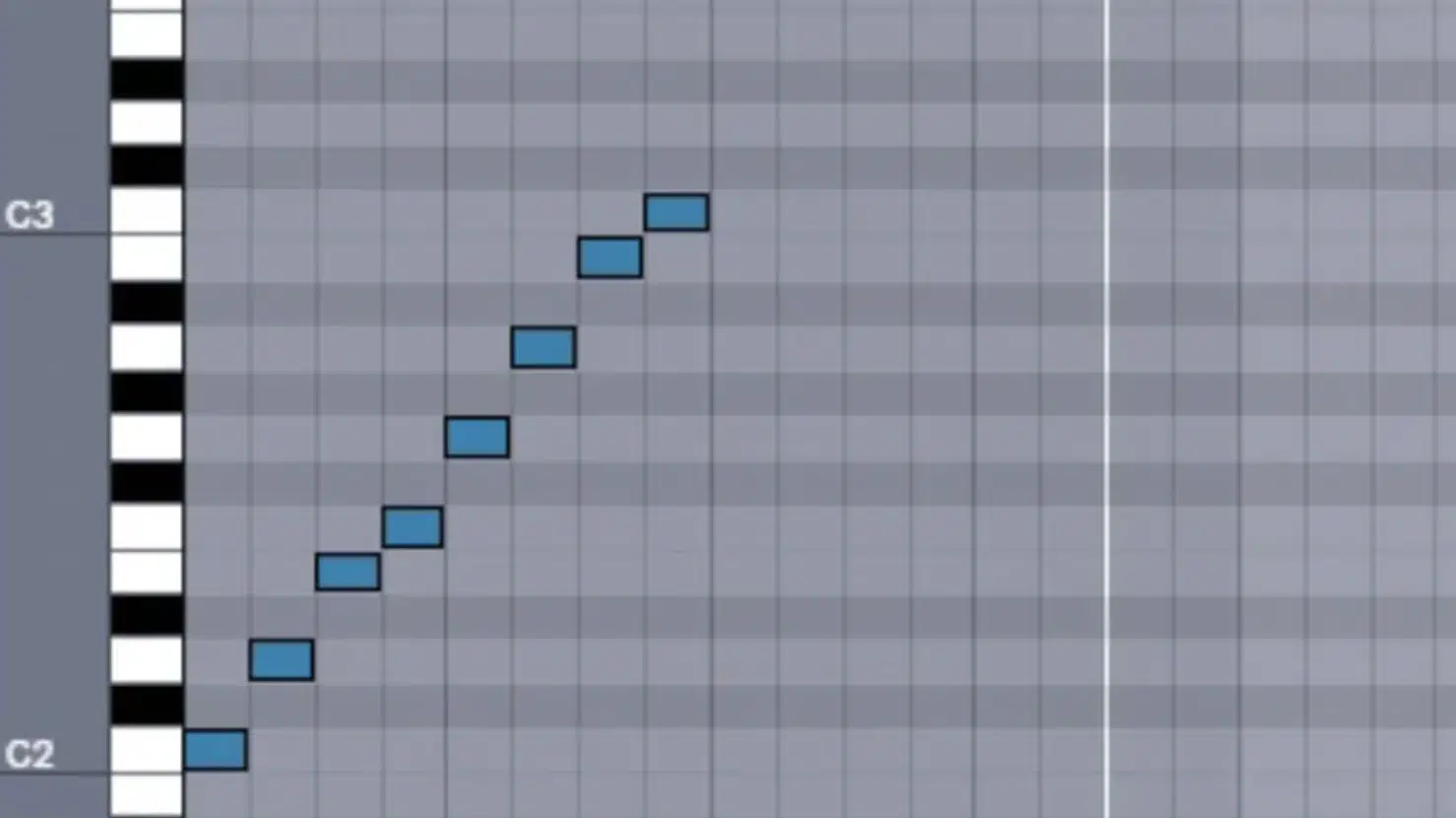
A Major Scale is often associated with happiness and brightness, follows a specific pattern of whole steps and half steps:
- Whole step
- Whole step (two semitones)
- Half step (one semitone)
- Whole step
- Whole step
- Whole step
- Half step
For instance, the C major scale uses the notes (starting on C): C, D, E, F, G, A, B, so there’s no need for any sharps or flats.

If you’d like to learn everything about the Major scale, we’ve got you covered.
-
A Natural Minor Scale
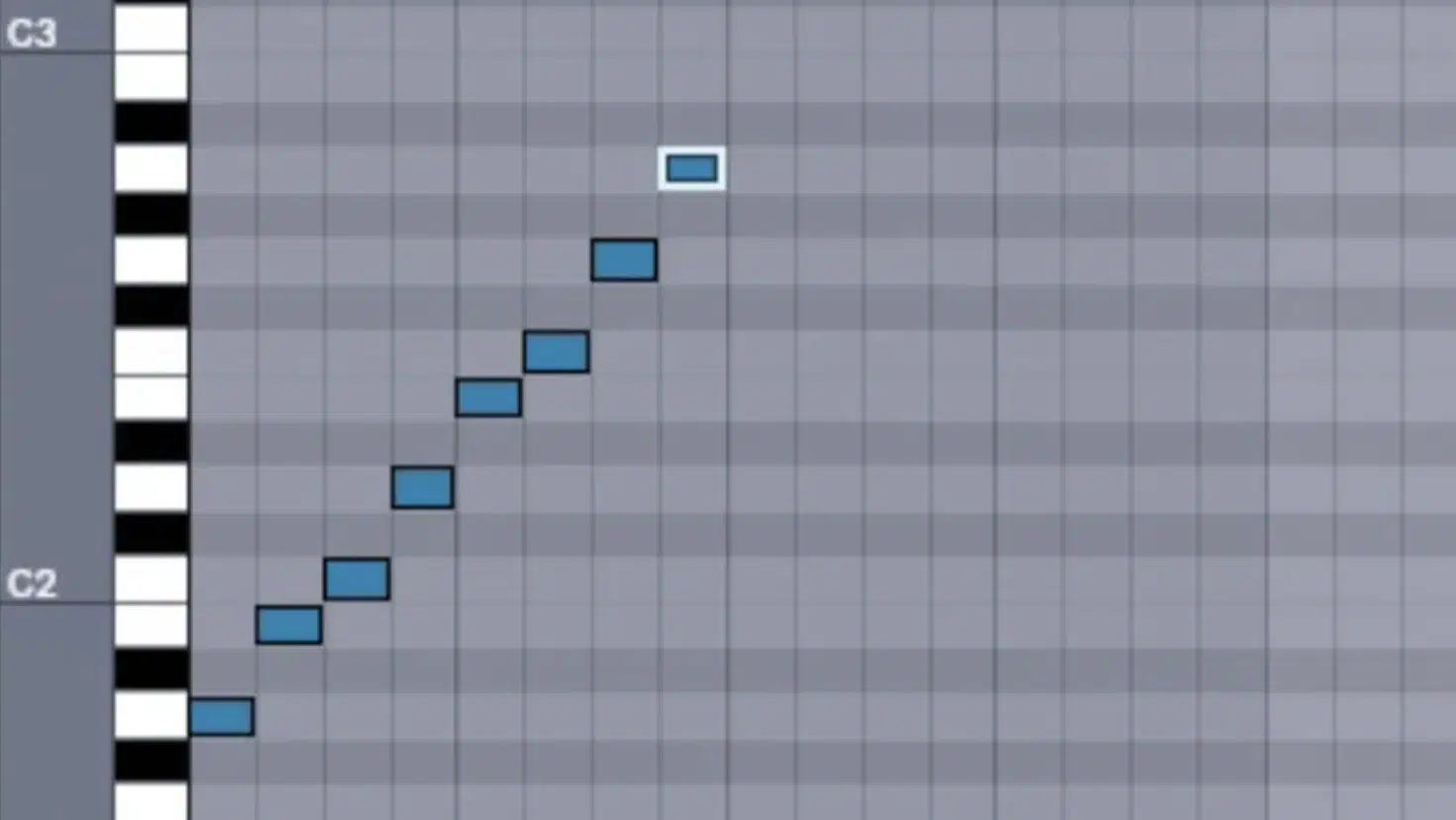
A Natural Minor Scale, which often conveys sadness or mystery, has a different pattern of whole steps and half steps, which is:
- Whole step
- Half step
- Whole step
- Whole step
- Half step
- Whole step
- Whlole step
Using A minor key as an example: A (starting note), B, C, D, E, F, G.

Notice the difference in tonality compared to its major counterpart, despite both unique scales being diatonic.
If you’d like to learn everything about the Minor scale, we’ve got you covered.
Chromatic notes come into play when we discuss other variations like harmonic and melodic minor scales.
These scales incorporate chromatic notes outside of their basic form 一 pulling chromatic notes directly from the chromatic scale to enrich the overall tonal quality.
Understanding the relationship between the chromatic scale and these Major scales and Minor scales can enlighten you with greater flexibility.
You’ll be able to transition between scales and create unique chord progressions.
And even add unexpected melodic twists to your music, with the help of major or minor scales.
Enharmonic Equivalents and Key Signatures
Music Theory provides a framework for understanding and expressing the infinite combinations of sounds in systematic ways.
Within this framework, there are certain concepts that are foundational to understanding chromatic scales.
And, among them, are the ideas of enharmonic equivalents and key signatures.
-
Enharmonic Equivalents
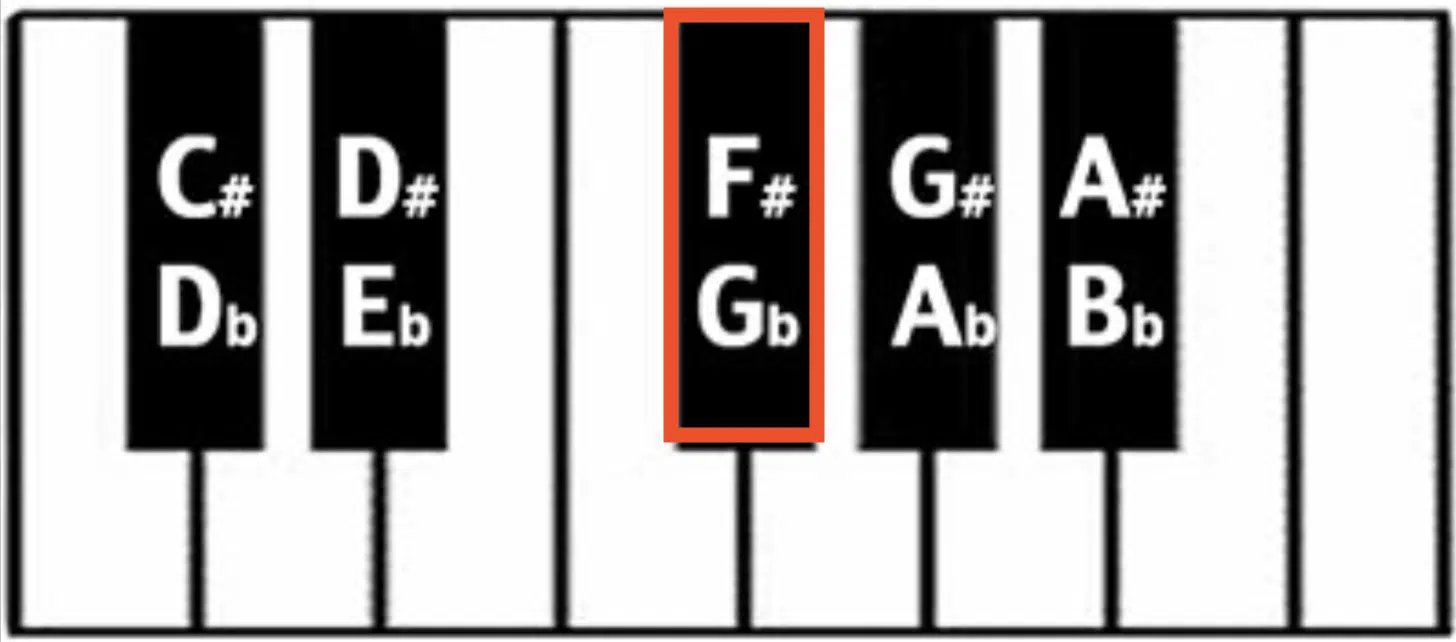
At its core, an enharmonic equivalent refers to two notes that sound the same but are written differently.
It’s a result of the way the musical alphabet is structured.
For instance, the note F# (F sharp) is an enharmonic equivalent of Gb (G flat) 一 even though they are represented differently, when played, they produce the same pitch.
-
Key Signatures
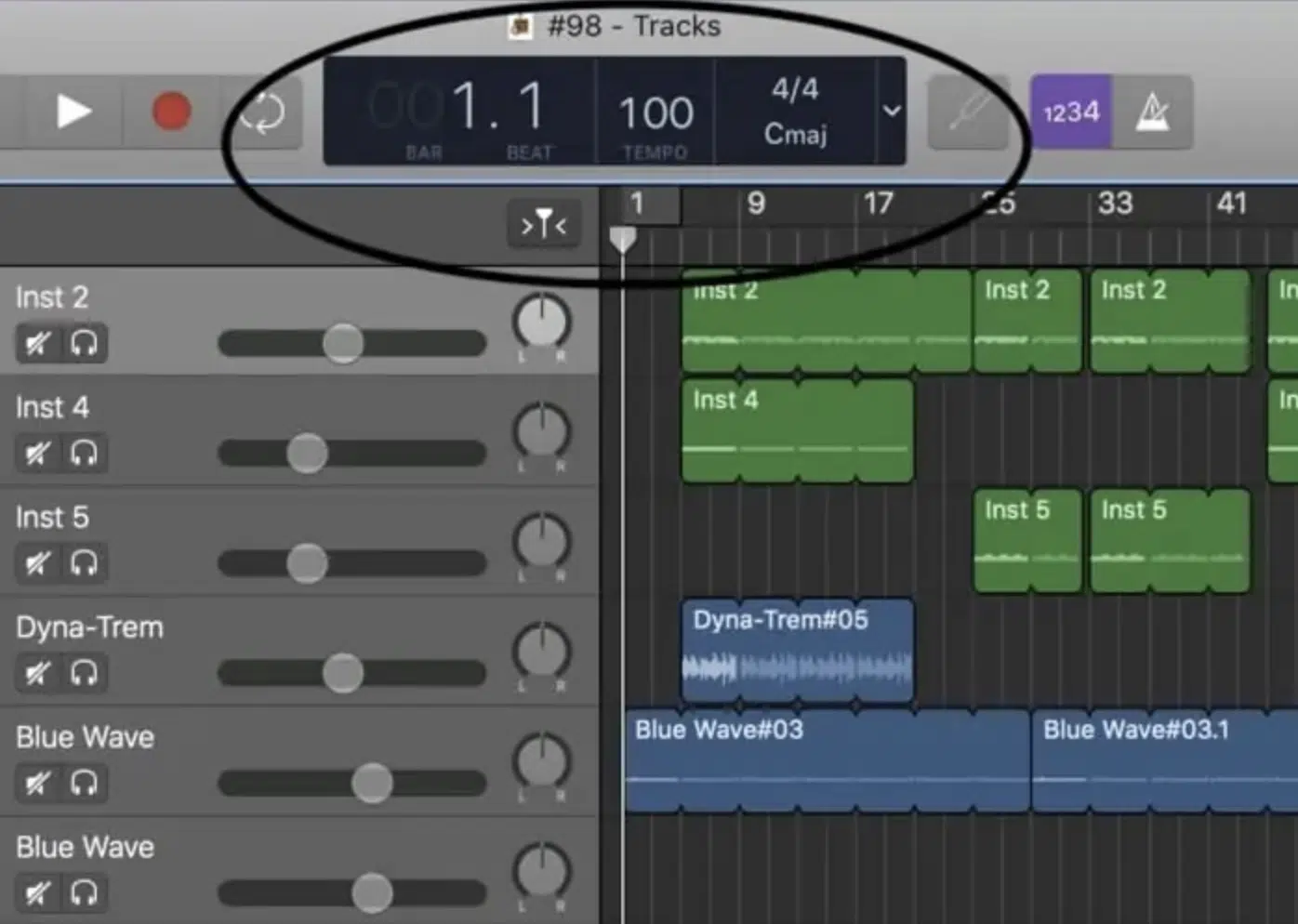
A key signature is a collection of all the sharps and flats used in a particular scale, and it’s notated at the beginning of a piece of music.
Placed right after the clef and before the time signature.
Its primary function is to indicate which notes should be consistently played sharp or flat throughout a piece.
By providing this information upfront, you can reduce the number of accidentals required in the music.
For instance, if a piece is in the key of G major, its key signature will have one sharp (F#).
This indicates that, every time an F is encountered, it should be played as F# unless otherwise noted.
Understanding these concepts is crucial for music producers.
Enharmonic equivalents allow flexibility in writing music, reading music, and arranging music 一 especially when transitioning between keys or when working with different instruments.
On the other hand, key signatures offer a clear framework for understanding the tonal foundation of a piece, making it easier to adapt, modify, or remix.
Chromatic Scale: Final Thoughts
The chromatic scale, with its richness and versatility, stands as a cornerstone in the world of music theory.
It’s not just a sequence of notes; when used with skill, it can completely transform the sonic landscapes of your tracks.
Whether you’re aiming for nuanced transitions, unexpected melodies, or simply wish to have a more profound understanding of the musical spectrum, the chromatic scale is the key.
After journeying through this article, you’re now equipped with the knowledge to harness the power of the chromatic scale like a seasoned professional.
But the journey doesn’t stop here…
To truly elevate your production game, the right resources can make all the difference.
That’s where this Free Advanced Scales MIDI Essentials pack comes it.
This pack doesn’t just offer you scales 一 it provides a complete toolkit to amplify your creativity.
With 24 unique, meticulously crafted MIDI scales, chord progressions, and melodies, your tracks will undoubtedly stand head and shoulders above the rest.
If you don’t have the advantage of a music theory degree, which most of us don’t, this pack can help deepen your grasp on the chromatic scale and a myriad of other scale types.
Which, of course, is super important when attempting to create show-stopping beats.
Armed with this knowledge and the right tools, your music is poised to leave an indelible mark in the minds of your audience.
Let the world hear your unique sound, colored and shaped by the intricate notes of the chromatic scale.
Until next time…







Leave a Reply
You must belogged in to post a comment.